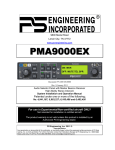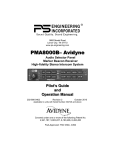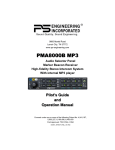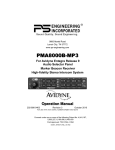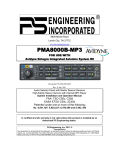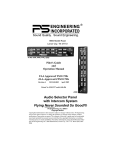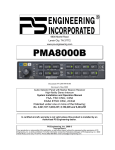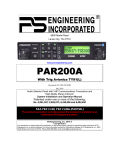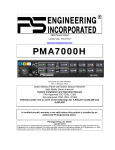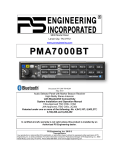Download Engineering Incorporated PMA9000EX Operating instructions
Transcript
9800 Martel Road Lenoir City, TN 37772 www.ps-engineering.com PMA9000EX Audio Selector Panel Marker Beacon Receiver High-fidelity Stereo Intercom System with Bluetooth Phone interface & MP3 player Pilot’s Guide and Operation Manual 202-920-0100 Revision 5 October 2010 This product is intended for Experimental Aircraft only. Covered under one or more of the following Patent No. 4,941,187, 5,903,227, 6,160,496, 6,493,450 OCT. 2010 202-920-0100 Page 1 This pilot guide provides detailed operating instructions for the PS Engineering PMA9000EX, Audio Selector Panel/Intercom Systems. Please read it carefully before using the equipment so that you can take full advantage of its capabilities. This publication covers the basic operating areas of the PMA9000EX systems. They are: Com Transceiver Selection, Receive Audio Selector, Intercom, Marker Beacon Receiver, Music, Front Panel Utility Jack and Telephone. PMA9000EX Controls 1.1 Power and Fail-Safe (1) Unit power is turned on and off by pushing the volume knob. In the OFF or "EMG" fail-safe position, the pilot headset is connected directly to Com 1 (will be heard in one ear, with stereo headset) as well as unswitched input #1. This allows communication capability regardless of unit condition. Any time power is removed or turned OFF, the audio selector will revert to fail-safe mode. The power switch controls all audio selector panel functions, intercom and marker beacon receiver. All pushbutton selections and menu modes will be remembered and return to the last state when turned on. 1.1 Communications Transmit (XMT) Selection (2) The two buttons C1 and C2, (# 2) in the XMT section control which communications radio is selected for transmitting. Push the lower button to select the desired COM transmitter. A green LED above the Page 2 PMA9000EX Pilot Guide Revision 5 button illuminates to indicate that the audio is selected. The top row of RCV pushbuttons (# 3) allows selection of the receiver audio. The PMA9000EX-Series has an automatic com receiver selector system. Audio from the selected transceiver is automatically heard in the headsets and speaker (if selected). You can check this function by switching from COM 1 transmitter to Com 2 transmitter by pressing the COM 2 transmitter selector pushbutton. See that the associated Com 2 receive pushbutton indicator light that is located immediately above the Com 2 transmitter pushbutton turns green. This guarantees that the pilot will always hear the audio from the transceiver selected for transmit. The PMA9000EX “remembers” the receiver selection, so that when switching transmitters from COM 1 to COM 2, if COM 2 audio was previously selected, COM 1 audio will continue to be heard. This eliminates the pilot having to switch Com 1 audio back on, after changing transmitters. When switching from COM 1 to COM 2 while Com 2 was not previously selected, COM 1 audio will be switched off. In essence, switching the mic selector will not override prior selection of COM receiver audio. In normal (not split) modes, the PMA9000EX gives priority to the pilot’s radio Push-To-Talk (PTT). If the copilot it transmitting, and the pilot presses his PTT, the pilot’s microphone will be heard over the selected com transmitter. 1.1.1.1 Split Mode The split mode can be activated at any time by pressing the C1 and C2 XMT buttons at the same time. This places the pilot on COM 1 and the Copilot on COM 2. All four COM indicators will illuminate to indicate that the panel is in split mode. In split mode, the intercom will remain active in the selected mode, however, and music will be muted in the crew positions. Pilot on COM 2 and Copilot on COM 1 is not possible. Split Mode does not turn off Nav, ADF, or Aux selected audio to pilot. However, the copilot will only hear the copilot-selected com receiver and unswitched inputs OCT. 2010 202-920-0100 Page 3 NOTE Due to the nature of VHF communications signals, and the size constraints in general aviation aircraft, it is probable that there will be some bleed-over in the Split mode, particularly on adjacent frequencies. PS Engineering makes no warranty about the suitability of Split Mode in all aircraft conditions. 1.1.1.2 Swap Mode (Switch from Com 1 to Com 2 remotely) With a yoke mounted, normally open momentary switch, the pilot can change from the current Com transceiver to the other by depressing this switch. To cancel "Swap Mode," the pilot may either press the yoke mounted switch again, or select a different Com with the XMT buttons. 1.1.1.3 Internal Recorder The PMA9000EX comes equipped with an internal recorder. This digital system stores the last incoming audio from the radio you have selected for transmit. It can store up to 60 seconds of audio. The pilot and copilot hear the playback. Because of the continuous nature of AWOS recordings, these will not trigger the recorder circuits. 1.1.1.3.1 Playback Recording is automatic. To play back the message, press and hold the XMT button for the communications radio that is selected for transmit for about 1 second or until the message plays back. To stop the playback, hold the same button until the playback stops, about 2 seconds. Then the next 1-second press will play the next earlier message stored. The playback will stop automatically when the selected com audio becomes active again. Press the button again to start the message again. The audio received during playback is NOT stored. Page 4 PMA9000EX Pilot Guide Revision 5 1.2 COM Audio Receive Selector (3) Communication audio from the other radio, not selected for transmit, can be heard by pressing the associated RCV button. You will always hear the audio from the selected transceiver. 1.3 NAV Audio selection (4) VHF Navigation receiver audio is selected through two momentary, push-button, backlit switches. VHF Navigation aid audio push buttons are labeled N1, N2. The users can identify which receivers are selected by noting which green LEDs are lit above the button. 2.0 Marker Beacon Receiver (5) 2.1 Marker Beacon Operation (5) The Marker Beacon Receiver uses visual and audio indicators to alert you when the aircraft passes over a 75 MHz transmitter. The Blue lamp, labeled “O”, is the Outer Marker lamp and has an associated 400-Hertz 'dash' tone. The lamp and tone will be keyed at a rate of two tones/flashes per second when the aircraft is in the range of the Outer Marker Beacon. The Amber lamp, labeled “M”, is the Middle Marker lamp and is coupled with a 1300 Hertz tone. It is keyed alternately with short 'dot' and long 'dash' bursts at 95 combinations per minute. The White lamp, labeled “I”, is the Inner marker and has a 3000 Hertz 'dot' tone. The lamp and tone will be keyed at a rate of six times per second. The MKR button controls audio selection, marker sensitivity, and audio muting, and lamp test. • MKR button press of < 1 second: toggles between high and low receiver sense OCT. 2010 202-920-0100 Page 5 • MKR button press between 1 and 2 seconds: Activates audio mute, and marker lamp test activated. The next beacon received will re-activate the audio. • MKR button press > 2 seconds: toggle marker audio on/ off. When the audio is selected, MKR will appear in the display. Marker audio can also be controlled using the same manner as Secondary Navaid Selection Use "HI" sensitivity initially. This allows you to hear the outer marker beacon about a mile out. Then touch the smaller MKR button to switch into Low Sensitivity mode. “LO” sensitivity gives you a more accurate location of the Outer Marker. Holding the MKR button for two seconds activates marker test lamp, which illuminates all three lamps simultaneously to assure the lamps (internal and external) are in working order. Releasing the button returns to the last sensitivity. The marker audio level is preset at the factory, and a service adjustment is available if necessary. 3.0 Intercom (6) 3.1 IntelliVox® VOX-Squelch No adjustment of the IntelliVox® squelch control is necessary. There is no field adjustment. Through three individual signal processors, the ambient noise appearing in all six microphones is constantly being sampled. Non-voice signals are blocked. When someone speaks, only their microphone circuit opens, placing their voice on the intercom. The system is designed to block continuous tones, therefore people humming or whistling in monotone may be blocked after a few moments. For consistent performance, any headset microphone must be placed within ¼-inch of your lips, preferably against them. (ref: RTCA/DO214, 1.3.1.1 (a)). It is important to have the microphone element parallel to your mouth, and not twisted inside the cover. It is also a good idea to keep the microphone out of a direct wind path. Moving your head through a vent air stream may cause the IntelliVox® to open momentarily. This is normal. The IntelliVox® is designed to work with normal aircraft cabin noise levels (70 dB and above). Therefore, it may not always recognize speech and clip syllables in a quiet cabin, such as in the hangar, or without the engine running. This is also normal. Page 6 PMA9000EX Pilot Guide Revision 5 Oregon Aero MicMuff Part Numbers Note: For optimum microphone performance, we recommend use of a Microphone Muff Kit from Oregon Aero (1-800-888-6910). This will not only optimize VOX performance, but will improve the overall clarity of all your communications. Headset Manufacturer Model Part Number Bose Dynamic Electret M87 90010 90015 90020 David Clark H10-30 H10-20, H10-40 H10-13.4, 13X H20-10X 90010 90015 90015 90015 Lightspeed All 90015 Peltor 7003 ANR Pro, 7000 90010 90015 Pilot 11-20, 11-90, 1776, DXL 90015 Sennheiser All 90015 Telex Airman 750, AIR4000 AIR3000, Echelon 100 90010 90015 3.2 Intercom Modes The “ICS” pushbutton switch on the left side of the PMA9000EX provides the selection of the three intercom modes. This button cycles through the intercom modes, from left to right and then back, ISO, ALL, CRW (Crew), ALL, and ISO. The illuminated text shows the active mode . ISO: The pilot is isolated from the intercom and is connected only to the aircraft radio system. He will hear the aircraft radio reception (and sidetone during radio transmissions). The copilot and passengers will hear the music sources as configured by the audio panel. ALL: All parties will hear the aircraft radio and intercom. Crew will hear Entertainment 1, passengers can hear Entertainment 1 or 2. During any radio or intercom communications, the music volume automatically decreases. The music volume increases gradually back to OCT. 2010 202-920-0100 Page 7 the original level after communications have been completed. An Alternate Intercom Function is available that prevents the passengers from hearing aircraft radios in ALL mode. See Section 4.2 for details. CREW: Pilot and copilot are connected on one intercom channel and have exclusive access to the aircraft radios. Again, the music that the crew and passengers will hear is controlled in the music distribution setup. 3.3 Intercom Volume Control (7) The small volume control knob adjusts the loudness of the intercom for the pilot and copilot. It has no effect on selected radio levels, music input levels or passengers' volume level. The larger, outer volume control knob controls intercom volume for the passengers. It has no effect on radio or music levels. Adjust the radios and intercom volume for a comfortable listening level. Most general aviation headsets today have built-in volume controls; therefore, volume also can be further adjusted at the individual headset. 3.3.1 Mono Headsets in Stereo Installation The pilot and copilot positions work with stereo or mono headsets. All passenger headsets are connected in parallel. Therefore, if a monaural headset is plugged in to a PMA9000EX Stereo installation, one channel will be shorted. Although no damage to the unit will occur, all passengers will lose one channel, unless they switch to the “MONO” mode on the headset. 4.0 EnCoder And Push Switch interface (ECAPS) (8) ECAPS is a system that consists of two encoding data knobs and a push-push switched integral into the small data knob. These control the menu, submenus, and selection of items for control. The primary menu contains frequently accessed items: SPR (cockpit Speaker), TEL (telephone) MKR (Marker audio), and MUTE (music mute control). Pressing the small knob for two (2) seconds will activate the sub menus. Submenus contain: ADF, DME and AUX audio, MP3 and Page 8 PMA9000EX Pilot Guide Revision 5 other music selections and controls, Alternate Intercom mode control, Public Address, and LCD display controls. Turn the large data knob to view the sub menus. Turn the small knob to toggle selections on or off, or adjust levels. OCT. 2010 202-920-0100 Page 9 Pushing the small data knob will activate the option, and exit the menu, or, the option will be selected automatically after five (5) seconds. The menu function will always come up on the display with last used function first. 4.1 Cockpit Speaker The speaker (SPR) can be turned on or off in the same manner as the MKR from the primary menu. This control will place all selected audio on the cockpit speaker when this switch is selected. Except for the unswitched audio, the speaker amplifier is not active in the "Split Mode”. Unswitched audio, (the inputs dedicated to autopilot disconnect, altimeter warning, etc.) will come through the speaker regardless of the speaker button position. Depending on installation, important audio annunciations such as radar altimeter or autopilot disconnect will come over the speaker even if it is not selected, while other unswitched, but muted inputs, such as GPS alerts, will only be present if the SPR button is selected. Consult your professional avionics installer for these important configuration details. 4.2 Standard/Alternate Intercom Function Alternate Intercom Function is a mode that allows everybody to talk on the intercom, but the passengers do NOT hear the aircraft radios. In addition, when the aircraft radios are active, the crew does not hear the passengers’ microphones, although passengers continue to hear each other. This function is selected through the ECAPS system. 4.3 Utility Jack (9) The 2.5-millimeter (3/32”) jack on the front of the PMA9000EX has three distinct functions: • Music input • Advisory audio input • Wired Cell phone input 4.3.1 Front Jack Music Input When used as a music input, the front panel jack is treated as Music #1. However, thanks to the PMA9000EX controls, it can be Page 10 PMA9000EX Pilot Guide Revision 5 distributed to all users, regardless of the intercom mode. A patch cord is available with 2.5 mm to 3.5 mm (3/32" to 1/8" ) adapter cord (PS Part Number 425-006-2535). 4.3.2 Audio Advisory Input The front jack can be used as a priority advisory input for auxiliary systems such as a GPS terrain advisory or OCT. 2010 Crew 202-920-0100 Page 11 portable traffic watch system. To prevent radio or intercom from muting this input, turn off the “Mute” function. 4.2.2.1 Smart Jack Function When the PMA9000EX has a signal on music #1 input coming in from the rear connector, the front panel jack automatically becomes a Priority Advisory input, and is heard in the crew headphones. NOTE The front jack is no substitute for the certified installation of alerts such as the GPS waypoint or autopilot tones. These still must be hard wired into the back by your installer. 4.3.3 Cellular phone When a wired cellular telephone is connected to this jack using available 2.5 mm to 2.5 mm adapter cord (PS Part Number 425-006-7026), the PMA9000EX audio panel will connect the intercom to the cell phone when the “TELEPHONE mode is activated, and behave as described in section 4.3.2. The telephone ringer, if present, will be heard unless the input is muted by other radio or intercom., however, with the wired connection, the TELEPHONE RINGING message will not be displayed. 4.3 Telephone (TEL) Mode The TEL mode serves as a full duplex interface and distribution for compatible portable cellular phones with hands free jacks or Bluetooth capable. 4.3.1 Bluetooth Before the PMA9000EX can be used in TEL mode with a Bluetooth connection, the unit must be paired with a specific phone. Activate the “seek device” function on the cell phone, and then enter the access code “0000” when the phone detects the “PMA9000EX” on the list of available devices. If the PMA9000EX doesn’t pair with the Bluetooth phone, (“Unsupported device” message, for example), verify that the audio panel is in the Hands free mode. Turn the audio panel off, and then back on, while holding the Nav 1 button, until “Hands Free Mode” is displayed. If Headset Mode is displayed, repeat the process of holding Nav 1 button while the audio panel is powered up, until Hands Free is displayed. Units are delivered in Hands free mode. Page 12 PMA9000EX Pilot Guide Revision 5 This process will be necessary for any phone to be used, and only one cell phone can be pared with the audio panel at a time. If the additional phones are paired with the PMA9000EX, only the first phone will transfer audio to the panel. 4.3.1.2 Using Bluetooth When using Bluetooth, the PMA9000EX will display “TELEPHONE RINGING” and play a ring tone. Pressing the encoder knob will connect the call. The PMA9000EX exits the telephone mode automatically when the cellular phone hangs up. To make an outgoing call, select TEL using the ECAPS system. Using the cell phone, dial the desired number and select “send” on the cell phone. You now connected to the telephone. NOTE: You will continue to hear the selected Com. When you press the PTT, the cell phone will mute. Note to iPhone users: When dialing out from the phone, or when an incoming call is answered from the phone, it may be necessary to manually select the “PMA9000EX” as an audio source on the main phone screen of the iPhone. 4.3.2 Telephone Distribution The TEL mode connects the telephone to the users as follows: In ALL mode, all crew and passengers will be heard on the phone. Com and selected radio audio is also heard in the headsets. If the pilot or copilot pushes the radio PTT, their mic will be transferred to the selected Com radio. The telephone party will not hear ATC and vice versa. In CREW mode, only the pilot and copilot are connected to the telephone. Passengers will not hear the telephone. The pilot and copilot will also have transmit capability on the selected transceiver. In ISO mode, when the PMA9000EX is in the TEL mode, the pilot position is in the "Phone Booth." Only the pilot will hear the telephone, and only he will be heard. He will also have access to Com 1 or 2, and will transmit on that radio using the PTT. All selected audio is provided to the pilot. NOTE: Because the cellphone uses an intercom circuit, all stations on that circuit lose intercom capability when the cell phone is in use. WARNING FCC regulation 47 CFR 22.925 prohibits the use of 800 MHz Cellular OCT. 2010 202-920-0100 Page 13 handsets in any aircraft that is airborne. Violation of this rule could result in suspension of service and/or a fine. 4.4 Music Input & Distribution There are three music sources available to the PMA9000EX: MP3, Music 1, and Music 2. Music 1 input can be either on the front jack, OR the Music 1 input at the rear connector. Music 2 is wired into the rear connector only. The PMA9000EX has two music channels, which can use any of three sources. One music channel is provided to the crew, and can be distributed to the passengers. Another music input is dedicated to the Passengers stations. The three sources, Music 1, Music 2 and MP3 can be directed via the ECAPS to these channels. Note: If you don’t hear the music device as expected, verify which sources is selected for the crew. Page 14 PMA9000EX Pilot Guide Revision 5 If the MP3 player is selected for the crew, and music is playing in the front panel jack or Music 1, BOTH sources will be heard, because the front panel jack can also be used for alert audio and telephone. Select MUSIC DISTRIBUTION submenu, push the knob, and select the desired configuration from that menu. 4.4.1 Music Volume Music #1 volume is controlled by the small data knob at all times, unless the MP3 player is active, in which case the small data knob controls MP3 Volume. In addition, music input 1 and music input 2 have individual volume controls that are accessible through the ECAPS system. Push the OCT. 2010 202-920-0100 Page 15 small data knob for 2 seconds, and then turn the large data knob until MUSIC 1 or MUSIC 2 is shown. Then turn the small data knob to change the volume. The display will revert and store the values after 3 seconds. 4.4.2 Music Mute Control PMA9000EX controls the music muting allowing the user to tailor the SoftMute™ to their taste and situation. There are two SoftMute™ muting circuits. The SoftMute™ circuit will cut the music almost completely out whenever there is conversation on the radio or intercom. When that conversation stops, the music returns to the previous level comfortably, over a second or so. For those occasions when the music muting isn’t necessary or desired, the SoftMute can be disabled from the front panel. Push the small knob to highlight the cursor. Select the MUTE by turning the small knob, and push the knob again to toggle mute on or off. This mute control is for the Crew music only. Passenger music muting is controlled through a switch installed in a location convenient to the passengers. Page 16 PMA9000EX Pilot Guide Revision 5 4.4.3 MP3 On/Off The internal MP3 player can be turned on and off and the order of play can be either sequential or random. Each of these functions has a submenu item in the ECAPS system. The MP3 player resets to off when the PMA9000EX is turned off. 4.4.4 MP3 Volume The volume of the internal MP3 player can be adjusted at any time the player is on and main menu is displayed, by turning the small data knob. OCT. 2010 202-920-0100 Page 17 4.4.5 MP3 Music Track selection The track can be changed whenever the MP3 player is operating by turning the large data knob. The track title is displayed momentarily. The display also changes to show the title when the track changes. 4.4.6 MP3 Random Mode The PMA9000EX MP3 player can be set to play the files in sequence, or in a random order. The MP3 Random Mode is on the submenu. Page 18 PMA9000EX Pilot Guide Revision 5 4.4.7 MP3 File Transfer The PMA9000EX has 1 GB of internal storage (512 MB before S/N B01094). The program inside the unit will recognize and import any compatible audio files (.wav, .mp3, unprotected .wma) from an external source, through the USB cable. The PMA9000EX is not compatible with iTunes formats. 4.4.7.1 Laptop transfer Due to the transfer rate advantages, we recommend that you transfer files from a laptop to the PMA9000EX if possible. Direct USB device transfer requires 35-40 minutes to transfer 1G of songs, Laptops typically require 4-6 minutes for the same amount of data with USB 2 port. PS Engineering recommends Microsoft XP operating system or later. 1. Using the supplied 2.5 mm-to-USB cable, along with the supplied USB-to-USB adapter cord (PS Part number 425-003-1454), connect this set of cables from the PMA9000EX front panel jack to a PC USB port. 2. With the PMA9000EX turned off, push and hold the small data knob while powering the PMA9000EX on. Wait until the audio panel displays "USB drive mode" before releasing. 3. When windows recognizes the PMA9000EX as a removable drive, select “Open folder to view files using Windows Explorer” 4. Create a subfolder (name it whatever you wish, like “PlaneMusic”) on your PMA9000EX to contain the specific music files you will want on the airplane. 5. Copy the desired music into this folder. 6. After transfer is complete, turn the audio panel off, and back on to return to normal operation. 4.4.7.2 Direct USB Device Transfer For best results, the following procedure should be used for a USB device when used with the PMA9000EX. The USB drive should be reformatted before being used with the PMA9000EX and only music files should be stored, in a single subfolder on the USB Device. 1. Connect the USB Drive to your PC 2. From “Start” select “My Computer” and select the external drive. 3. Right Click on the device, and select “Format. . . “ OCT. 2010 202-920-0100 Page 19 4. Select “FAT” as File system, and “Start” WARNING, this will erase all files on this device. 5. After formatting is complete, right click in the drive, and select “New. . . Folder” and create a new folder for your music that you will put on your PMA9000EX 6. Transfer your music files into the new music folder. We recommend having no more than 1G of music files in this folder. To upload from a USB memory device, select the “Music Transfer” function on the submenu. Follow the onscreen instructions; connect the memory device to the 2.5mm to USB cable, and then plug the cable into the front of the PMA9000EX when prompted. We recommend that you only store 1G (512MB before Serial Number B01094) or less of files on the audio panel, to ensure that all the desired songs are played on the PMA9000EX. Because of the Microsoft file protocol, we cannot predict which files will be omitted Page 20 PMA9000EX Pilot Guide Revision 5 After the music transfer is complete, the PMA9000EX will automatically reset to store the files and create the new play list. Therefore it is not advisable to upload files in flight or when the audio panel is otherwise in use. Note: For best results, use quality name-brand USB devices. Different types of files, and music file programs may result in variation in the volume level of the stored music. The maximum transfer rate will decrease by about 1% each time the unit is uploaded, therefore frequent music upload is not advised. 4.5 Backlighting & Contrast The PMA9000EX has an automatic photocell dimming of the annunciation LEDs and marker lamps. Control of the text backlighting is through the aircraft avionics dimmer. The LCD display has backlighting controlled by the automatic photocell dimming. In addition, the text inverts for nighttime mode when the ambient light is low. As the light decreases to a dim sunlight, the LCD backlighting will turn on, and you may notice a brightening of the LCD under some conditions. The contrast on the LCD display can be controlled for individual preference. Activate the LCD CONTRAST submenu, and turn the outer knob to adjust the level. There are 10 steps, with 10 as the lowest contrast. NOTE: A contrast level of 3 or 4 is optimal. 4.6 ADF/DME/ AUX Monitoring ADF, DME and AUX (auxiliary) audio is available when selected through the ECAPS graphical and data conOCT. 2010 202-920-0100 Page 21 trol system. Press and hold the small data knob to activate the sub menu, rotate the large data knob to find the AUX, ADF or DME page. Rotate the small knob to toggle the audio on or off. When on, the letter A or D will appear in the primary display. Unlike ADF or DME, AUX is not annunciated on the primary display. 4.7 Public Address Function The Public Address (PA) can be activated through the ECAPS Public Address submenu. The pilot microphone will be heard on the speaker when the pilot PTT is used. The copilot can continue to use the selected com radio while the pilot will now be heard over the speaker. The C1 and C2 receive indicators blink to indicate that the pilot microphone is no longer connected to the radio or intercom. 4.8 Warranty & Service In order for the factory warranty to be valid, the installations in a certified aircraft must be accomplished by an FAA-(or other ICAO agency) certified avionics shop and authorized PS Engineering dealer. If the Page 22 PMA9000EX Pilot Guide Revision 5 unit is being installed by a non-certified individual in an experimental aircraft, a factory-made intercom harness must be used for the warranty to be valid. PS Engineering, Inc. warrants this product to be free from defect in material and workmanship for a period of two (2) years from the date of purchase from an authorized PS Engineering dealer. During the first twelve (12) months of the three-year warranty period, PS Engineering, Inc., at its option, will send a replacement unit at our expense if the unit should be determined to be defective after consultation with a factory technician. For the remaining twelve (12) months of the two-year warranty period, the shipping costs for the exchange unit will be borne by the customer. All transportation charges for returning the defective units are the responsibility of the purchaser. All domestic transportation charges for returning the exchange or repaired unit to the purchaser will be borne by PS Engineering, Inc. The risk of loss or damage to the product is borne by the party making the shipment, unless the purchaser requests a specific method of shipment. In this case, the purchaser assumes the risk of loss. This warranty is not transferable. Any implied warranties expire at the expiration date of this warranty. PS Engineering SHALL NOT BE LIABLE FOR INCIDENTAL OR CONSEQUENTIAL DAMAGES. This warranty does not cover a defect that has resulted from improper handling, storage or preservation, or unreasonable use or maintenance as determined by us. This warranty is void if there is any attempt to dissemble this product without factory authorization. This warranty gives you specific legal rights, and you may also have other rights, which may vary from state to state. Some states do not allow the exclusion of limitation of incidental or consequential damages, so the above limitation or exclusions may not apply to you. All items repaired or replaced under this warranty are warranted for the remainder of the original warranty period. PS Engineering, Inc. reserves the rights to make modifications or improvements to the product without obligation to perform like modifications or improvements to previously manufactured products. 4.9 Factory Service The units are covered by a two-year limited warranty. See warranty information. Call PS Engineering, Inc. at (865) 988-9800 before you return any unit. After discussing the problem with the technician and you obtain a Return Authorization Number, ship product to: PS Engineering, Inc. Attn: Service Department OCT. 2010 202-920-0100 Page 23 9800 Martel Rd Lenoir City, TN 37772 (865) 988-9800 FAX (865) 988-6619 Email: [email protected] Units that arrive without an authorization number, or telephone number for a responsible contact, will be returned un-repaired. PS Engineering is not responsible for loss of items in transit. Index ADF/DME/AUX.................22 Intercom Mode, Alternate ..................................... 10 Public Address............. 23 Audio Advisory Input .......11 Intercom Squelch ........... 6 Split Mode...................... 3 Audio Selector Panel..........2 Internal recorder............. 4 Telephone.................... 12 Cockpit Speaker ..............10 Laptop Connection....... 19 Telephone, Bluetooth .. 12 Data Knob ..........................8 Marker Beacon............... 5 Telephone, Cellular ..... 12 Backlight & Contrast ........21 MP3.............................. 17 Transmitter Select ......... 2 ECAPS ...............................8 Music Distribution......... 14 Volume, Intercom .......... 8 File Transfer .....................19 Music Mute................... 16 Volume, Music ............. 15 Front Panel Utility Jack ....10 NAV Selection................ 5 Warranty ...................... 23 Intercom .............................6 Power............................. 2 PS Engineering, Inc. 2008 © Copyright Notice Copyrighted information in this manual is subject to change without notice. PS Engineering reserves the right to improve or change the products or contents of this manual, without notification of any person or agency. The contents of this pilot’s guide may be downloaded, stored and reprinted for personal use provided that this copyright information is included. Commercial use is strictly prohibited. For further information contact the Publications Manager at PS Engineering, Inc., 9800 Martel Road, Lenoir City, TN 37772. Phone (865) 9889800 Page 24 PMA9000EX Pilot Guide Revision 5


























